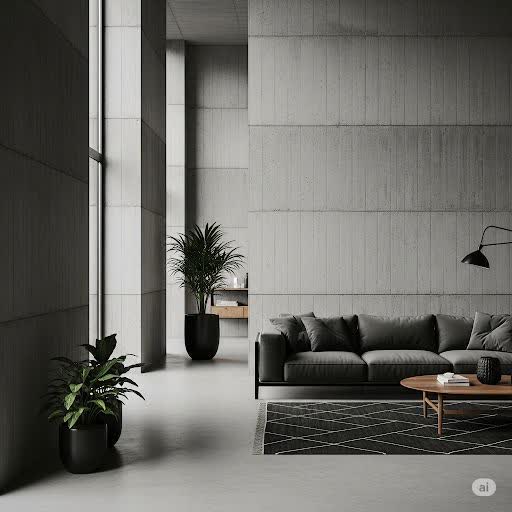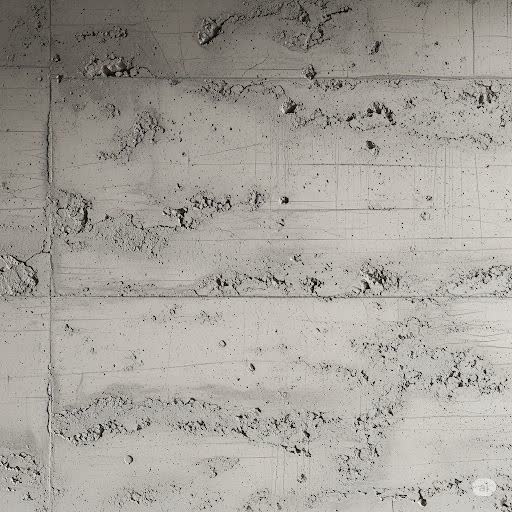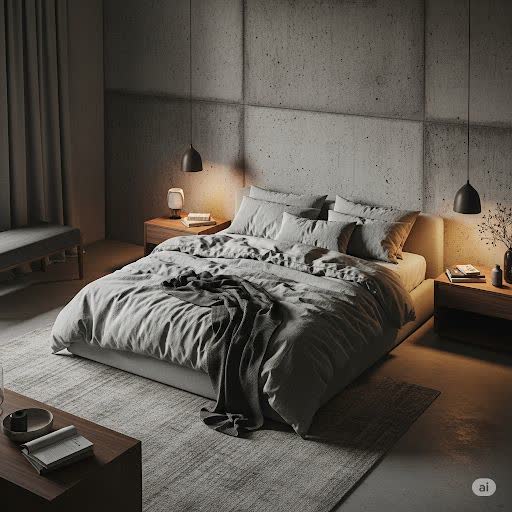Let’s call it what it is, the term brutalist interior design doesn’t so much say “cozy comfort” as it does. It conjures up images of stark, foreboding concrete structures, and for most, it’s an aesthetic that reads more like an icy shoulder than a warm hug. But imagine if I told you that this oft-misinterpreted look is not only making a large comeback but is also one of the most exciting and talked-about trends in the world of design right now? That’s right, the same brutalist interior design that’s been divisive for decades is currently at the forefront of modern style.
So, are you ready to venture into the raw, unexpurgated beauty of brutalist interior design? Here, we’re going to lift the lid off this wonderful style. We’re going to discuss its history, explore why it’s impressing so many homeowners and designers today, and most importantly, I’ll instruct you on how to incorporate the best of brutalist interior design in your own house in a way that’s both aesthetic and practical.
Shelve all that you think you know about brutalism; we’re going to approach it a new way. I promise you’ll be surprised. How warm and lively this new, so-called “brutal” aesthetic can be.

What Exactly is Brutalist Interior Design? Unpacking the Concrete Truth
First of all, let’s clear up a common myth. “Brutalism” does not come from the “brutal” we use in common parlance. Actually, it derives from the French béton brut, or “raw concrete.” This was famously used by pioneering early architect Le Corbusier to describe the poured-in-place concrete he used in his World War II era work. So, really, brutalist interior design is all about accepting the natural, unadorned beauty of materials. Open concrete, steel, wood, and brick, in their honest, natural form.
The Core Principles of Brutalism in Interiors
In order to arrive at the very heart of brutalist interior design, we need to look at its basic nature. It’s not a style; it’s a philosophy.
- Brutalist Honesty of Materials: This is a key principle of brutalism. Materials are left to be seen as naturally as possible. No plastering over the concrete, no wood-grain paint. Blemishes, texture, and unprocessed nature of the material are all adored. This is a main element in brutalist interior design.
- Monumental Forms: Large, monolithic forms and structures are common in Brutalist buildings. Think of a huge concrete fireplace in the middle of a room, or a sculptural, blocky staircase. These elements give a feeling of being there and permanence.
- Texture Focus: With its limited palette of colors, texture assumes a previously unheard-of level of significance in the context of brutalist interior design. The roughness of concrete, the wood grain, the weave of fabric – these are the things that bring warmth and interest to a space in the brutalist style.
- Function over Formality: Function is the primary interest of Brutalist design. Every item within the space needs to have a purpose. No playtime for shallower decoration here. This focus on function is one of the identifying features of brutalist interior design.
- A Monochromatic Colour Scheme: The colour scheme of the brutalist interior design tends to be subdued and monochromatic where grays, black, and white dominate. This allows the materials and the shapes to be the center of attention.
But don’t be fooled by this apparently harsh list. A beautifully executed brutalist interior design is really cozy and inviting. It’s a design that instructs you on how to appreciate the beauty of imperfection and the understatement of natural materials. For more on using concrete in your decor, see our how-to guide to concrete decor ideas for an industrial chic home.

The Raw Aesthetic: Why Brutalist Interior Design is Making a Comeback
So, why the sudden interest in brutalist interior design? In a world overwhelmed by a perpetual barrage of perfectly styled images on social media, there is an increasing craving for authenticity and a move back to something more earthy and real. Brutalist interior design, which prioritizes raw materials and imperfection, is a potent antidote to that digital perfection.
A Reaction to Perfection: The Rise of Imperfect Interiors
We are witnessing a move away from the perfect, mass-produced look that has overseen interior design for so long. Individuals are looking for spaces to feel authentic, have some character, and have a story. The raw, textural nature of brutalist interior design gives a sense of history and longevity that is difficult to match. This is where brutalist interior design truly shines.
The Influence of Modern Brutalist Interior Design
Modern applications of brutalist interior design are not an imitative reproduction of the monolithic, bare brutalist buildings of the mid-20th century. Modern brutalism is a more refined and humanesque interpretation of the style. Designers are now combining the raw textures of brutalism with softer nuances to create spaces that are both bold and inviting.
Take a concrete wall paired with a lush velvet sofa, or a knotty wood table balanced by a hand-woven rug. It is this blend of hard and soft, rough and smooth, that makes modern brutalist interior design so appealing. This shift makes brutalist interior design more mainstream and attractive to more people.
How to Incorporate Brutalist Interior Design in Your House (Without it Having a Bunker-Tie-In)
The concept of introducing brutalist interior design in your home might sound daunting. Memories of a grey, cold, and unfriendly space come flooding back. Fear not! There are some methods to adopt the brutalist look without compromising on warmth and coziness. The secret is balancing it well.
The Softer Side of Brutalism: Minimalist Brutalist Interior Design
The most popular method for using brutalist interior design in the modern era is probably through a minimalist style. Minimalist brutalist interior design combines the use of all the main elements of each style – the simplicity and lack of clutter from minimalism and the raw materials and texture focus of brutalism – to create a room that is both serene and thought-provoking.
To create this aesthetic, begin with a neutral color scheme. Next, add some notable pieces of brutalist furniture with bold, sculptural silhouettes. Have limited accessories, and allow the materials to do the talking. This style of brutalist interior design is ideal for achieving a soothing and meditative environment. For more information about minimalist living, you may like our blog about minimalist living: a guide to less is more.
Brutalist Furniture: Daring Statement with More Presence
It is not necessary to live in a concrete bunker to enjoy brutalist interior design. A couple of carefully chosen pieces of brutalist furniture can do to make a powerful statement in a space. Select furniture made from solid, heavy-duty materials like concrete, travertine, or black, heavy wood. The forms must be minimal, geometric, and sculptural. A chunky concrete coffee table, a raw-edged solid wood dining table, or steel and leather armchairs can all add a little bit of brutalist cool to your interior. The principle with brutalist furniture is to create a statement, so don’t be shy.

A Brutalist Interior Design Bedroom: Is This Your Concrete Sanctuary?
Is a brutalist interior design bedroom restful and relaxing? Yes, it can be! The secret is to contrast the cold, industrial components with soft, natural materials. A concrete accent wall at the back of a bed can serve as a show-stopping accent. Pair it with a low-profile, minimalist bed frame made of salvaged wood. Add a whole lot of soft textiles – think about the chunky knit throw blankets, linen bedding, and a plush wool area rug.
The right lighting is important too. For tips on choosing the perfect lighting, read our guide to the best lighting in your home. Warm, soft lighting will remove the harsh edges from the concrete and create a warm and inviting atmosphere. The final result is a brutalist interior design bedroom that is chic and serene – the perfect refuge in which to curl up after a long day.
Influential Brutalist Interior Designers You Should Know
Though Brutalism is commonly associated with architects, many interior designers have embraced and reinterpreted this powerful style. These are some names you should know:
- Paul Evans: An American furniture designer who rose to fame for his sculptural, metal furniture that beautifully embodies the brutalist philosophy.
- Kelly Wearstler: A contemporary designer who often incorporates brutalist elements into her glamorous and eclectic interiors. Her designs show how brutalist interior design can turn sleek and sophisticated.
- Axel Vervoordt: A Belgian designer celebrated for his wabi-sabi aesthetic, which shares many principles with brutalism, such as an appreciation for imperfection and natural materials.
Exploring the work of these designers can provide a wealth of inspiration for your own brutalist interior design journey.
The Great Debate: Why is Brutalist Interior Design So Controversial?
There is no doubt but that brutalist interior design is a polarizing fashion. For each person who is drawn to its plain-spoken honesty and its straightforward forms, there’s someone else who doesn’t care for its coldness, its oppressiveness, and, yes, its brutality. The controversy is only one of the reasons that brutalist interior design is so interesting.
The biggest objection to brutalism is its perceived coldness and lack of ornamentation. In an age when beauty is so often reduced to ornament, the bare, unornamented surfaces of brutalist interior design can be jolting. But its champions argue that this is precisely its strength. They see beauty in its honesty, its functionality, and its unwillingness to apologize for raw materials.
As the Tate museum notes in its analysis of brutalism, the style developed due to a desire for a new kind of architecture that was “serious, honest and would not date” (Tate). That sentiment is no less real in the field of interior design today. Last but not least, love it or despise it, no one can deny the aggressive presence of brutalist interior design and its residual influence on the world of design.
Summary of Key Points
- Brutalist interior design isn’t about being “brutal,” but about the beauty of raw material (béton brut).
- Guiding principles are honesty of materials, monumental scale, focus on texture, and functionality.
- The resurgence of brutalist interior design is a reaction to social media perfectionism and a desire for authenticity.
- Modern brutalism is a toned-down, people-focused take on the style.
- You can incorporate brutalist interior design into your home in a minimalist aesthetic, with standout brutalist furniture, or with a balanced brutalist interior design bedroom.
- Brutalist interior design is controversial, but its honesty and directness are the very reasons why so many are so attracted to it.
So, what are your thoughts on brutalist interior design? Would you be willing to adopt the look, or is it a little too far for your style? I’d love to hear your comments below! And if you enjoyed this article, don’t forget to share it with your design-loving friends.
Ready for more design inspiration? Be sure to read the rest of the articles on serenihouse.com for more tips, trends, and ideas to get you creating a home you will love.
FAQ
What is a brutalist interior design?
Brutalist interior design is a style characterized by the use of raw, unfinished materials like concrete, steel, and brick. Functionality, texture, and size in monumental forms are preferred over ornamentation. The look is direct, plain, and leans towards very sculptural in character. The goal of brutalist interior design is to create a space that is real and functional.
What is Brutalism design mean?
The philosophy of Brutalism architecture, either in structures or interior design, is the design aspect of “béton brut” or raw concrete. It arose post-World War II as a reaction against the perceived frivolity of past designs. The integrity of the idea is the honest expression of material, structure, and function. It’s a style that champions imperfection and raw power of unadorned form, and therefore brutalist interior design is a statement of authenticity.
Who are the famous brutalist interior designers?
While Brutalism is generally an architectural movement, there are some designers who are known for brutalist-inspired interiors and furniture too. Paul Evans is one such noted designer whose furniture is very sculptural and textural in metal. Kelly Wearstler, in contemporary design, often uses large-scale, brutalist elements in her eclectically styled environments. Natural materials and wabi-sabi used in the work of Axel Vervoordt are also a reflection of the ideology of brutalist interior design.
Why is Brutalism controversial?
Brutalism is not popular because its harsh, austere look is perceived by some as cold, unfriendly, or even “brutal.” Its bulk, raw-concrete shapes can weigh heavy, and its lack of ornamentation goes against traditional notions of beauty. But proponents of brutalist interior design appreciate its honesty, its rugged individuality, and its rejection of superficiality. This harsh contrast of opinion is at the very center of its identity.
